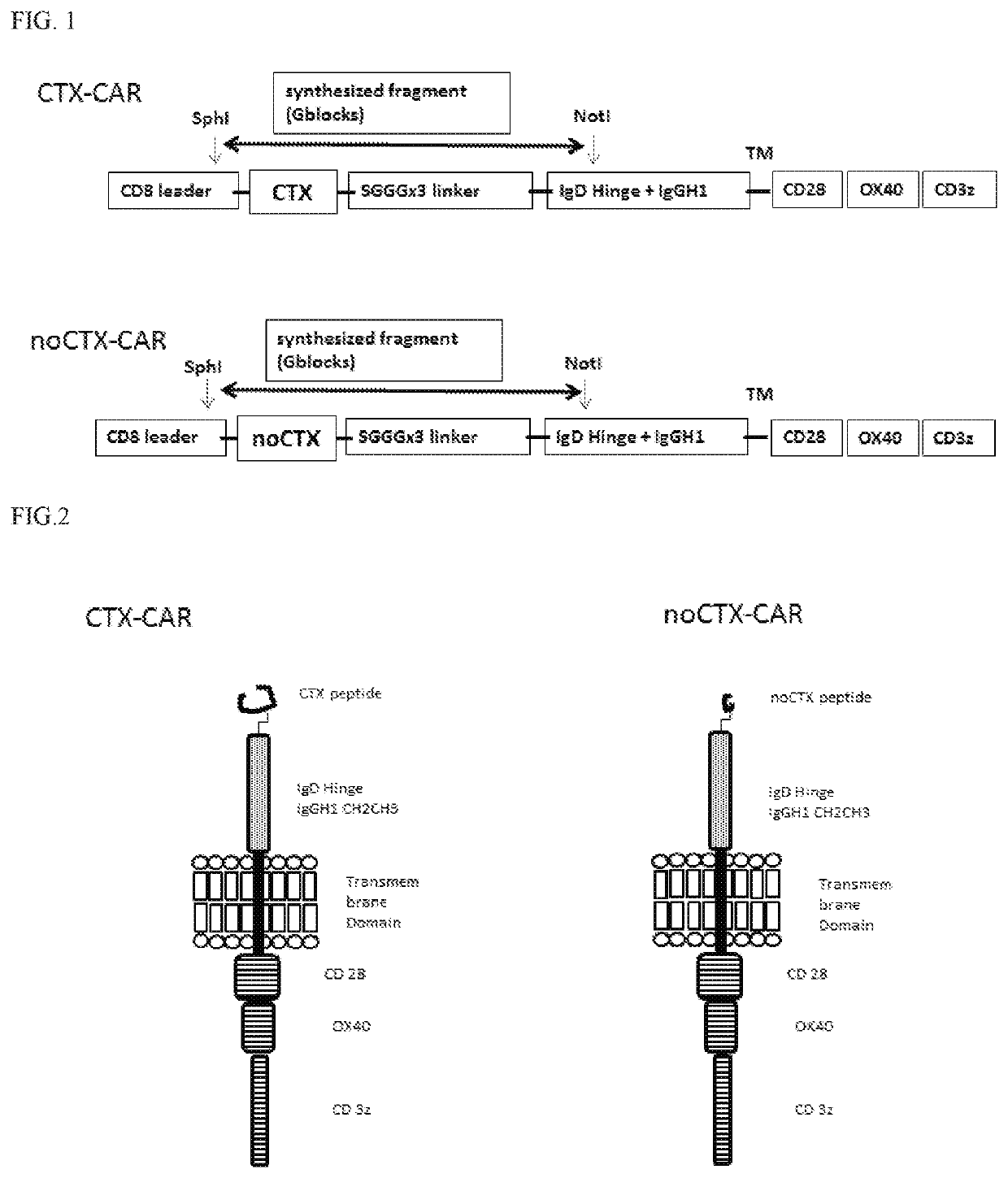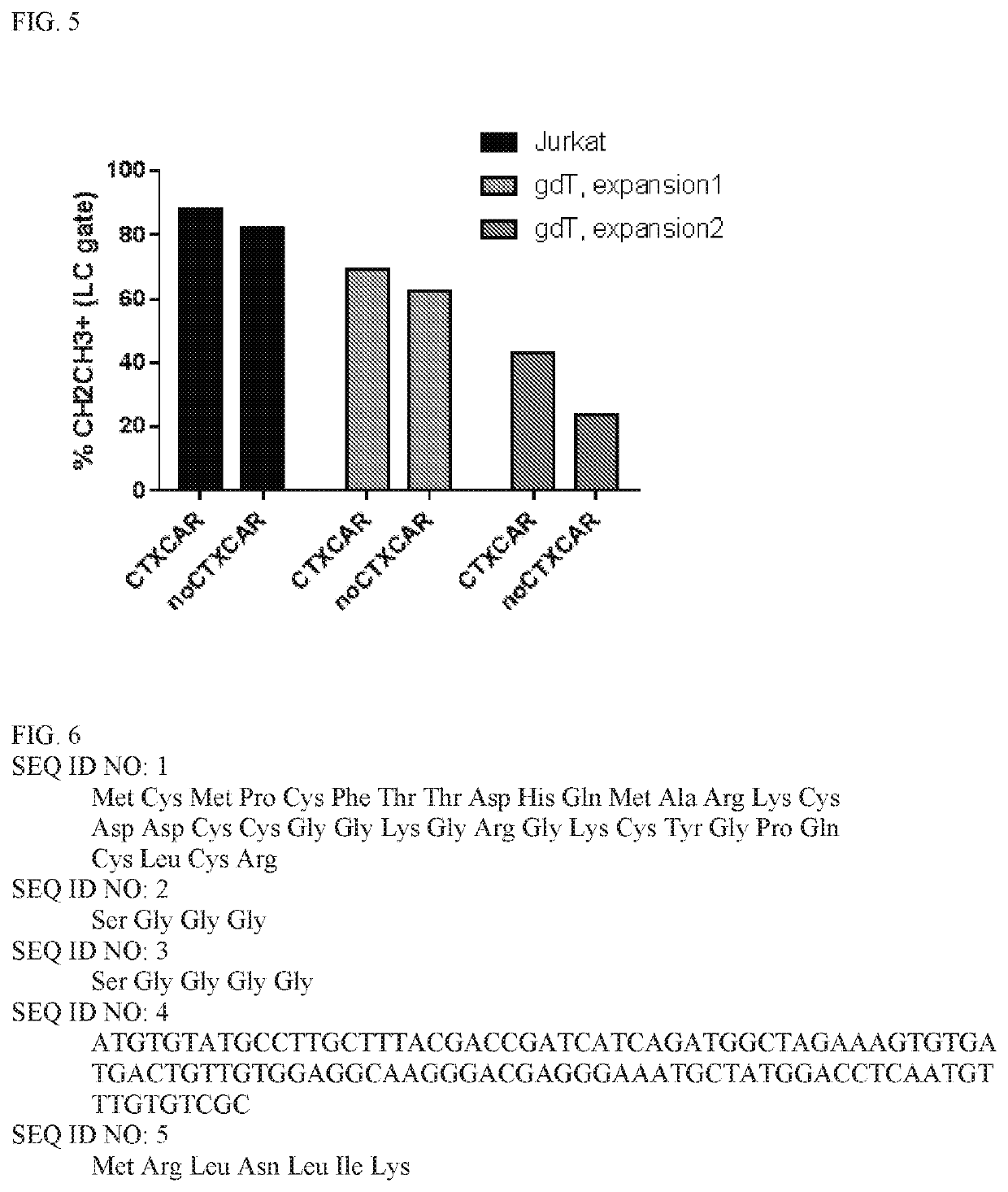Chimeric chlorotoxin receptors
a technology of chimeric chlorotoxin and receptor, applied in the direction of drug compositions, peptides, blood/immune system cells, etc., can solve the problem that ctx cannot bind normal tissues derived from neurological diseases, brain, skin, kidney and lung or other non-tumorigenic tissues, etc., to enhance the cytotoxity of effector cells
- Summary
- Abstract
- Description
- Claims
- Application Information
AI Technical Summary
Benefits of technology
Problems solved by technology
Method used
Image
Examples
example 1 -
Example 1-Methods for Generating a CTX-CAR and noCTX-CAR
[0110]To engineer T-cells expressing the CARs of the interest, CTX-CAR and the noCTX001-CAR genes were synthesized using G-block technology (IDT). Briefly, for the synthesis of the CTX-CAR the amino acid sequence of chlorotoxin (Scorpion venom; PRF: 445665) MCMPCFTTDHQMARKCDDCCGGKGRGKCYGPQCLCR (SEQ ID NO: 1) was converted to nucleotide using publicly available online software and codon optimized using the Integrated DNA technologies (IDT) online codon optimization tool having the sequence ATGTGTATGCCTTGCTITACGACCGATCATCAGATGGCTAGAAAGTGTGATGAC TGTTGTGGAGGCAAGGGACGAGGGAAATGCTATGGACCTCAATGTTTGTGTCGC (SEQ ID NO: 4).
[0111]The optimized nucleotide sequence was synthesized using G-block technique (IDT), to be cloned in frame with CD8-alpha leader sequence at 5′, and linker sequence SGGG ×3, an extracellular domain comprising the IgD hinge and IgG1 CH2 and CH3 domains, a transmembrane domain from CD28 and an intracellular signaling dom...
example 2 -
Example 2-Generating T Cells and Jurkat Cells Expressing the CTX-CAR and noCTX-CAR
[0113]CTX-CAR and the noCTX-CAR vectors were used for transfection of 293T-cells together with gag-pol and env (RDF) plasmids to obtain viral supernatants. Resulting viruses were applied to transduce Jurkat E1-6 T-cell line in order to test expression of both CARs by flow cytometry using CH2CH3 AB (detecting the IgD Hinge of the CAR molecule). Subsequently, the transduction of T-cells with retroviral vectors encoding both CARs was performed.
[0114]Briefly, 293T-cells were co-transfected with a) CTX-CAR or b) noCTX-CAR plasmids together with env (RDF114) and gag-pol (PEG-PAM) to obtain viral supernatants. 293T were collected after 72 hrs and stained with CH2CH3 antibody (to signify CAR expression). The unshaded portions in FIG. 4 show untransfected 293T-cells stained with CH2CH3 antibody and the shaded portion shows CTX-CAR transfected 293T-cells (left panel) and noCTX-CAR transfected 293T-cells (right p...
example 3
lls Expressing a CTX-CAR Selectively Bind Target Glioma Cells
[0116]This example shows that effector cells expressing a CTX-CAR of the present disclosure selectively bind to glioma cells. Binding properties of effector cells expressing a CTX-CAR of the present disclosure or noCTX-CAR were tested using both glioma cells lines U87, U251 and LN229 as well as using primary human astrocytes (ScienCell Research Labs) (HA) and primary αβ T-cells (TLC). Jurkat cells were transduced with retroviruses encoding CTX-CAR or noCTX-CAR constructs shown in FIG. 1 and as described in Example 1 using the protocol described in Example 2.
[0117]Glioma cell lines and primary cell lines were grown under standard conditions. Adherent target cells were trypsinized and labeled with the green fluorescent dye calcein. Jurkat cells expressing a CTX-CAR of the present disclosure (CTX-CAR) or a noCTX-CAR (noCTX-CAR) were stained with an allophycocyanin (APC)-labelled anti-CH2CH3 antibody (which binds to the hinge ...
PUM
| Property | Measurement | Unit |
|---|---|---|
| cellular resistance | aaaaa | aaaaa |
| multidrug resistance | aaaaa | aaaaa |
| primary structure | aaaaa | aaaaa |
Abstract
Description
Claims
Application Information
 Login to View More
Login to View More - R&D
- Intellectual Property
- Life Sciences
- Materials
- Tech Scout
- Unparalleled Data Quality
- Higher Quality Content
- 60% Fewer Hallucinations
Browse by: Latest US Patents, China's latest patents, Technical Efficacy Thesaurus, Application Domain, Technology Topic, Popular Technical Reports.
© 2025 PatSnap. All rights reserved.Legal|Privacy policy|Modern Slavery Act Transparency Statement|Sitemap|About US| Contact US: help@patsnap.com



